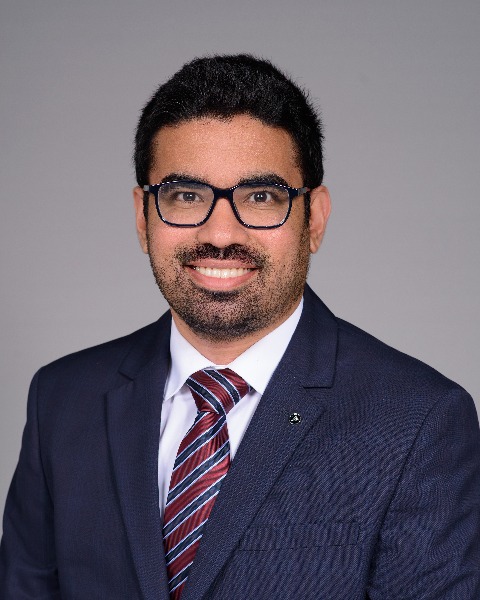Back
Poster Session C - Monday Afternoon
C0562 - Novel Approach in the Management of Large Portosystemic Shunt Causing Recurrent Hepatic Encephalopathy
Monday, October 24, 2022
3:00 PM – 5:00 PM ET
Location: Crown Ballroom

Apaar Dadlani, MBBS
University of Louisville
Louisville, KY
Presenting Author(s)
Introduction: Portosystemic shunting (PSS) is a common complication of advanced cirrhosis, and is usually a result of portal hypertension. In severe cases, it can lead to worsening hepatic encephalopathy (HE) leading to multiple hospitalizations. We present a patient with a large PSS who failed initial embolization of the PSS, requiring subsequent TIPS placement as well as re-embolization.
Case Description/Methods: A 55-year-old male with a history of non-alcoholic steatohepatitis (NASH) cirrhosis presented with altered mental status (AMS) for 2 days and worsening abdominal distension for a week. He did not report any fever, vomiting, or blood in stool. On chart review, he had multiple admissions for AMS secondary to HE. His caretaker reported compliance with home lactulose, rifaximin and zinc. A full infectious workup was negative. Abdominal ultrasound with doppler revealed no flow in the main portal vein. CT scan of the abdomen showed a massive PSS identified extending from the level of the splenic vein to the inferior vena cava, essentially shunting blood away from the portal vein. Patient underwent embolization of this PSS, however, this did not significantly decrease the blood flow through this shunt. Subsequently, a TIPS was placed to redirect flow into the portal vein and reduce flow in the shunt. Repeat embolization of the PSS was successful and resulted in almost no flow through the PSS with improved flow in the main portal vein. Since then, he has not had any further admissions with HE.
Discussion: Spontaneous PSS occurs as a result of worsening liver disease in cirrhotic patients, and their manifestations vary based on their location. In a study by Simón-Talero et al, ~50% of patients with large PSS had episodic and persistent HE. Patients with HE are usually treated medically with lactulose, rifaximin, or zinc, and treatment of the trigger (infection, GI bleeding, substance use). In a study on 25 patients with large PSS undergoing embolization, Lynn et al demonstrated a 100% success rate in immediate post-procedure improvement. However, in our patient, there was continued flow in spite of embolization of the shunt. Hence, we performed a TIPS procedure with repeat embolization of the shunt which ultimately minimized the blood flow through the large PSS and redirected flow into the portal vein. This novel modality of treatment may be beneficial in PSS which don’t respond to embolization, and further studies may be needed to understand the benefit in such refractory cases.
Case Description/Methods: A 55-year-old male with a history of non-alcoholic steatohepatitis (NASH) cirrhosis presented with altered mental status (AMS) for 2 days and worsening abdominal distension for a week. He did not report any fever, vomiting, or blood in stool. On chart review, he had multiple admissions for AMS secondary to HE. His caretaker reported compliance with home lactulose, rifaximin and zinc. A full infectious workup was negative. Abdominal ultrasound with doppler revealed no flow in the main portal vein. CT scan of the abdomen showed a massive PSS identified extending from the level of the splenic vein to the inferior vena cava, essentially shunting blood away from the portal vein. Patient underwent embolization of this PSS, however, this did not significantly decrease the blood flow through this shunt. Subsequently, a TIPS was placed to redirect flow into the portal vein and reduce flow in the shunt. Repeat embolization of the PSS was successful and resulted in almost no flow through the PSS with improved flow in the main portal vein. Since then, he has not had any further admissions with HE.
Discussion: Spontaneous PSS occurs as a result of worsening liver disease in cirrhotic patients, and their manifestations vary based on their location. In a study by Simón-Talero et al, ~50% of patients with large PSS had episodic and persistent HE. Patients with HE are usually treated medically with lactulose, rifaximin, or zinc, and treatment of the trigger (infection, GI bleeding, substance use). In a study on 25 patients with large PSS undergoing embolization, Lynn et al demonstrated a 100% success rate in immediate post-procedure improvement. However, in our patient, there was continued flow in spite of embolization of the shunt. Hence, we performed a TIPS procedure with repeat embolization of the shunt which ultimately minimized the blood flow through the large PSS and redirected flow into the portal vein. This novel modality of treatment may be beneficial in PSS which don’t respond to embolization, and further studies may be needed to understand the benefit in such refractory cases.

